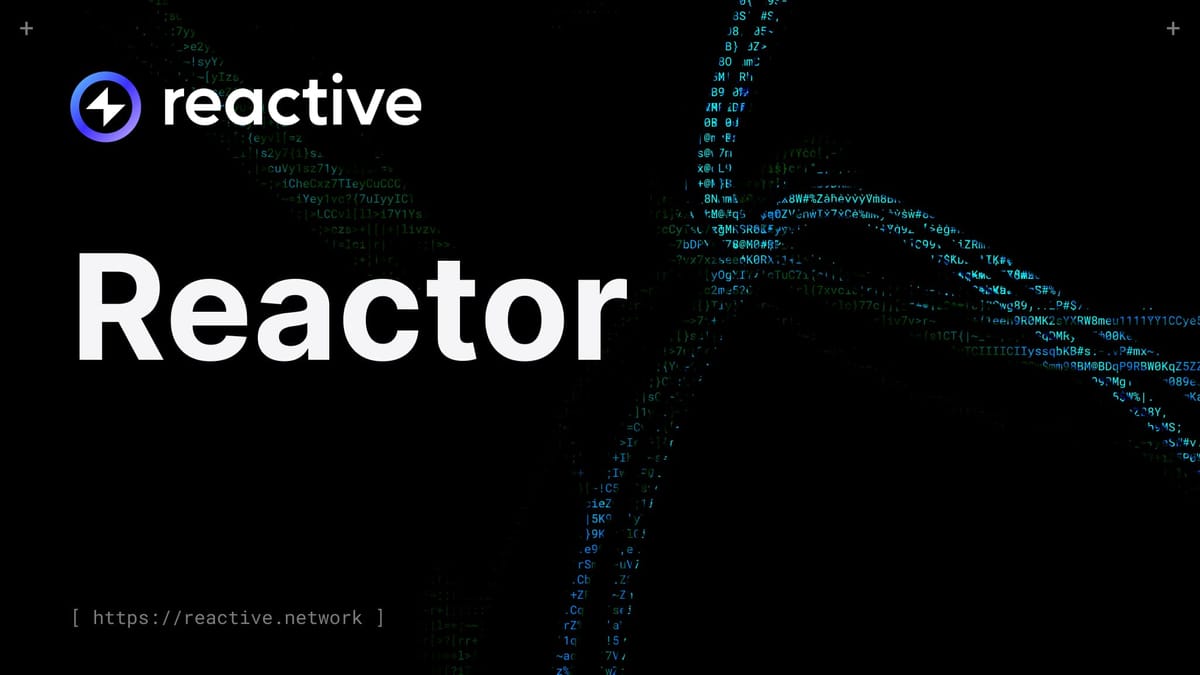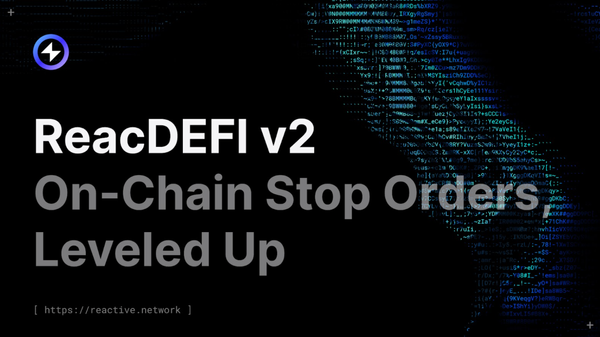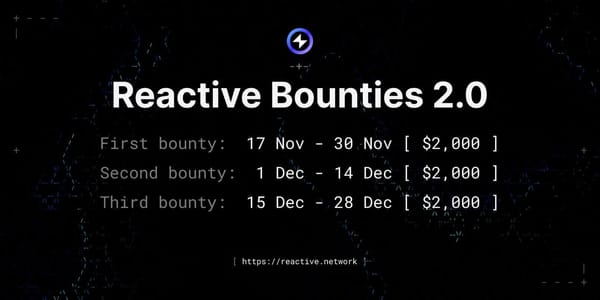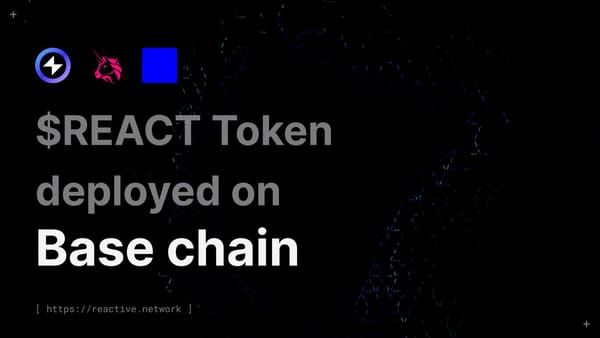Reactor: No-Code Automation for DeFi, Cross-Chain Workflows, and Beyond
Reactor is a no-code automation platform built on Reactive Network, empowering users to deploy smart contract strategies across chains without writing code. From stop-loss orders to real-time DeFi workflows, Reactor simplifies automation for everyone—from Web3 beginners to power users.

Blockchain technology offers unprecedented financial freedom — but often at the cost of complexity. Managing DeFi strategies, deploying smart contracts, or handling cross-chain workflows usually demands technical expertise. Reactor changes that. It’s a no-code automation platform designed to make decentralized finance accessible, secure, and intuitive for users at any skill level.
Key Features
Reactor lets users deploy smart contract automations without writing code. Its template-driven system supports strategies like recurring token swaps, market condition triggers, or scheduled actions. Setup is guided and foolproof: select a template, configure with clear on-screen instructions, and deploy. Each automation is optimized for gas efficiency and monitored in real time via an interactive dashboard that puts full control in the user's hands.
Reactor goes beyond single-contract actions to support complex workflows across multiple DeFi protocols and blockchains. Real-time data feeds power strategies like yield farming optimization, automated portfolio rebalancing, or cross-chain swaps — all without manual intervention. Users can coordinate assets and strategies across ecosystems, from one unified platform.
Reactor includes pre-built libraries of audited smart contracts and DApp automations. Users can launch pre-configured strategies, such as Uniswap stop-loss orders or ERC-721 tracking, in just a few clicks. These verified templates eliminate guesswork and accelerate deployment, giving users the confidence to automate without risk.
At the current stage, users need to have REACT in their wallet to use automations. However, in future versions, this requirement will be removed — users will only have to cover gas costs with native tokens on the destination chain.
Stop Order Automation
Step 1 – Reactor Main Page
Navigate to the main page of Reactor. Scroll down until you reach the Popular Automations section and locate the Create Stop Order option. Click on the Get Started → button to begin configuring your stop order automation.
Step 2 – Select Chain and Tokens
You will be prompted to select the desired chain and enter the token addresses for Token 1 and Token 2. These are the two tokens involved in the trading pair (e.g., WETH/DAI).
Click Find Pair to proceed. A section titled Find Pairs will appear, displaying all existing pairs that match the provided tokens. Once you’ve identified the correct one, click Use This Pair.
At this point:
- The Token and Pair fields will auto-populate.
- You’ll only need to specify the Token to Sell.
- If your wallet is already connected, your Client Address will be filled in automatically.
? Tip: If you know the pair address, skip the above by scrolling directly to the Create Stop Order section and pasting the pair address into the Uniswap V2 Pair Address field.
Step 3 – Price Threshold Settings
Define the price at which your stop order should execute. This is done using the Coefficient and Threshold fields, which work together to determine the triggering price condition.
For example, to trigger a sell when the price drops to 95% of the current market price, set Coefficient to 1000 and Threshold to 950. This means the stop order will activate once the token’s price falls to 0.95 of its current value.
Step 4 – Define the Amount to Sell and Fund Contracts
Specify the exact amount of tokens you want to sell when the stop order triggers. Be sure to approve at least this amount beforehand. Next, provide sufficient funding to both the Destination and Reactive (RSC) contracts. This funding covers gas costs when your automation is executed.
The recommended funding values are 0.03 ETH for a destination contract and 0.05 REACT for a reactive contract. You can either use the recommended values or customize them based on your transaction cost estimates.
Step 5 – Finalize and Deploy
After completing all required fields, click Create Stop Order. A wallet prompt (e.g., MetaMask) will appear for approvals and confirmations.
If everything is successful, you will see a Stop Order Created Successfully! message confirming the setup.
Create a Reactive Contract
Step 1 – Access Deployment Page
From the main Reactor page, click the Deploy RSC header to begin setting up a reactive automation contract.
Step 2 – Event-Function Mapping
Define how your reactive contract should listen for blockchain events and trigger corresponding functions. The required fields are Event Signature – the event you want to monitor, Function Signature – the function to call in response, and Topic0 – auto-generated keccak256 hash of the event signature, used internally for event filtering.
⚠️ Important: The first parameter of the destination function must be an address to support ReactVM processing.
Examples:
- Event Format: Transfer(address,address,uint256)
- Function Format: triggerAction(address,uint256,string)
Input Rules:
- Valid types: address, uint256, string, bool, bytes32, uint8
- No spaces between argument types
- Ethereum addresses must be valid (begin with 0x)
- Chain IDs must be positive integers
Click Add Automation to configure additional event-function pairs.
Step 3 – Chain and Contract Addresses
Now provide the network and contract details:
- Origin Chain ID: The chain where the monitored event originates
- Destination Chain ID: The chain where the function will be executed
- Origin Contract Address: Smart contract emitting the event (must already be deployed)
- Destination Contract Address: Contract containing the function to be called (must already be deployed)
✅ If both origin and destination contracts are on the same chain, check the "Origin and Destination are the same" box. Refer to Reactive Docs for the full list of supported networks.
Step 4 – Enable Pausible, Deploy, and Fund
Toggle the Enable Pausible Functionality if you want the ability to pause and resume event monitoring. This is especially useful for production deployments where you might need to temporarily suspend automated actions.
Click Generate Contract to review and copy the generated code if needed. Then:
- Fill in the Funding Amount to cover transaction costs.
- Press Deploy & Fund RSC
- Approve the transaction in your wallet (e.g., MetaMask)
Once successful, you will see a Deployment Successful message, along with:
- Deployed contract address
- Transaction hash
You're now ready to start automating cross-chain smart contract workflows using Reactor!
Templates Library
Step 1 – Access the Templates Section
On the main Reactor page, scroll down to the "Build the Future of DeFi Automation" section. Click the </> Start Building button.
Next, locate the Use Templates section and click Select.
Step 2 – Choose a Library
You will now be prompted to choose between the Smart Contracts Library and the DApp Library. In each section, you have the option to either View Templates or Contribute.
Smart Contracts Library: Clicking View Templates will take you to the RSC Use Cases Explorer, where you can:
- Browse detailed existing use cases
- Review the source code
- Submit your own use case
To submit a use case, you'll need to complete the following form:
DApp Library: Clicking View Templates will lead you to the DApp Automation Examples section, where you can:
- Explore detailed DApp automation examples
- Review the associated code
- Submit your own use case
To contribute your own, fill out the submission form provided.
Recap
Reactor removes the barriers to DeFi automation with a platform built for both newcomers and experts. Its intuitive design, smart templates, and cross-chain support make complex blockchain operations simple and safe. With upcoming features like a mobile app and deeper protocol integrations, Reactor is shaping the future of accessible DeFi.
About Reactive Network
The Reactive Network, pioneered by PARSIQ, ushers in a new wave of blockchain innovation through its Reactive Smart Contracts (RSCs). These advanced contracts can autonomously execute based on specific on-chain events, eliminating the need for off-chain computation and heralding a seamless cross-chain ecosystem vital for Web3’s growth.
Central to this breakthrough is the Inversion of Control (IoC) framework, which redefines smart contracts and decentralized applications (DApps) by imbuing them with unparalleled autonomy, efficiency, and interactivity. By marrying RSCs with IoC, Reactive Network is setting the stage for a transformative blockchain era, characterized by enhanced interoperability and the robust, user-friendly foundation Web3 demands.
Website | Blog | Twitter | Telegram | Discord | Docs





